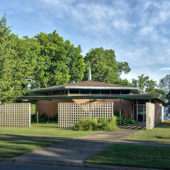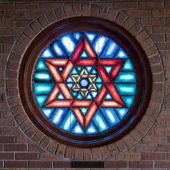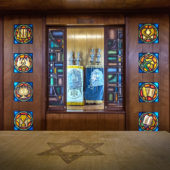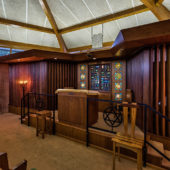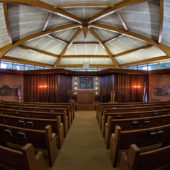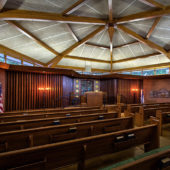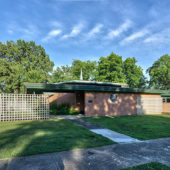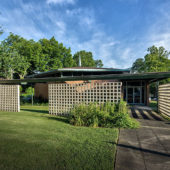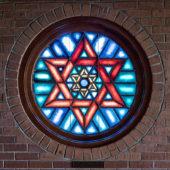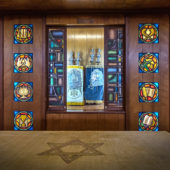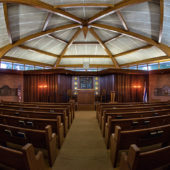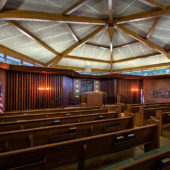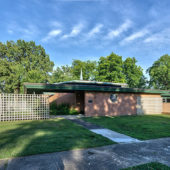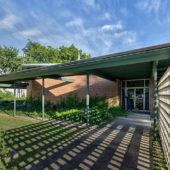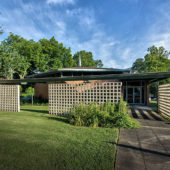A small congregation with a long history serving the Jews of north-eastern Arkansas.
Provided by the Jewish Community of Jonesboro:
HISTORY OF TEMPLE ISRAEL
JONESBORO, AR
The Marcus Berger, Sr. family became the first recorded Jewish family in Jonesboro when the new firm of Berger & Company was established in 1882. Other families joined the community during the next ten years, including that of Issac Goldstein, grandfather of current member Marguerite Culver, who arrived in Jonesboro in 1891. Although no official congregation existed in those early years, we know the High Holydays were observed. The Craighead County Sun reported on October 2, 1891, “The store of Marcus Berger & Company will be closed beginning this evening at 6:00 pm and continuing over 24 hours, this being a Jewish Holyday.”
Temple Israel was duly organized in January, 1896, with R.H. Meyers its president. Rabbi I. Rubenstein was the first rabbi of the congregation and served until his death on January 16, 1899. (Rabbi Rubenstein was the first person to be buried in the Temple Cemetery.) The decision to build the original Temple was made at the b’r;it of Jim Morris Schoenfield in 1897, and formal dedication of the building was held January 2nd, 1898. The “Dedication Program” and the original “Presentation of Keys Address” by Rosa Schoenberger from the 1898 dedication are on display in the social hall. The original Temple, located on Main Street, was used continuously for worship until the present Temple was built.
The congregation was served by resident rabbis from 1896 through 1922. For the period 1923 to 1935 the congregation was too small to employ a full-time rabbi and various laymen conducted weekly services, with student rabbis from Hebrew Union College in charge of services for the High Holydays. Beginning in 1936, Temple Israel was able to share a rabbi with the congregation at Blytheville. The rabbi came to Jonesboro on a bi-weekly basis for Shabbat services. Temple Israel continued to utilize student rabbis for the High Holyday services during this period.
By 1953 the congregation had grown large enough to afford bi-weekly and High Holyday visits by student rabbis. Because of the growth of the congregation, the number of children in the religious school, and the hope that the congregation would continue to grow, the decision was made to build a new Temple. Dedication services for the current building were held October 9,1960. From the 1984-1985 temple year through the 1989-1990 temple year, the congregation had tri-weekly Shabbat services as well as High Holyday services. From 1990- 1991 to the present, Temple Israel has had High Holyday services as well as monthly Shabbat services. Although small in number, the members are strong in spirit and committed to supporting Temple Israel so that it may continue to serve the needs of the Jewish community of Jonesboro.
HISTORY OF SISTERHOOD -TEMPLE ISRAEL
The most complete records of Temple Israel are the Sisterhood minute books dating from November, 1918, to the present. “The Ladies Aid Of Temple Israel” (precursor to the current Sisterhood) was established in 1899 to support the Temple and Cemetery. The minutes chronicling the Sisterhood activities provide a detailed commentary on life in the Jewish community of Jonesboro for the last 78 years. The ladies met each month from September through May. It is through their attendance sheets that we can trace the families who have made up the membership of the congregation.
In the early days it was the women of the Temple who took care of Temple business and made arrangements for the rabbis and services. They collected the dues, paid yearly assessments to the Hebrew Union College, rented the parsonage, and made decisions about building repairs and improvements. It was 1947 before separate checking accounts were maintained for the Sisterhood and the Temple.
From the beginning the sisterhood has been generous in its support of local and national charities. St. Bernard’s Hospital, Jonesboro Library, Jonesboro Orphanage, Leo N. Levy Hospital and the Orphans Home in New Orleans were all yearly beneficiaries of funds and volunteer hours. In 1926, Temple Israel Sisterhood joined the National Federation of Sisterhoods and the charter was signed in the home of Onita Hummelstein. Funds for all these activities were provided by dues, gift raffles held at each meeting, community bridge parties, and by each member saving pennies during the summer months.
The banking crisis in the 1930s meant a loss of almost $1,000.00 in funds. The ladies quickly replenished their funds by foregoing their usual refreshments and decorations at each meeting. Instead, each hostess gave the money they normally would have spent to the Sisterhood. Through the generosity of the members, the money was recouped in one year.
As Jonesboro began to grow in the 1950s, the Sisterhood added active members and launched new money-making projects such as the Chanukah Happening Bazaar, annual bulb sales, a cookbook titled “What’s Cooking” and rummage sales. These projects funded charity donations and temple building maintenance. The ladies also conducted religious school for the children. The religious school has been an important part of Temple Israel, and it was through the efforts of Sisterhood that the children of Temple Israel were able to receive a religious education. For many years the sisterhood has assumed responsibility for the Passover Seder. The recent publication of a new cookbook One Hundred Years of Kneading The Dough allowed the Sisterhood to sponsor this centennial celebration.

